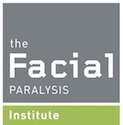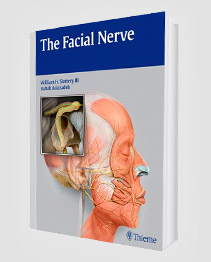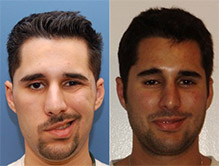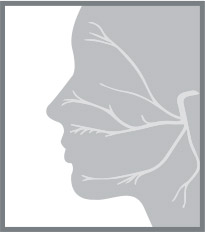What Is the Facial Nerve-Parotid Gland Connection?
The facial nerve-parotid gland relationship is unique. And, for patients who require parotid tumor removal, it is beneficial to work with a surgeon who understands this relationship.
What Is Parotid Tumor Removal?
Parotid tumor removal, also known as a parotidectomy or parotid surgery, is used to address abnormal growths that form on one the parotid glands.
The parotid glands are located in front of the ears, with one gland on each side of the face. They are salivary glands that help people chew and digest food.
Tumors can develop on one or both of the parotid glands and cause facial swelling and numbness. They can also result in facial paralysis or weakness.
There are several kinds of parotid tumors, including:
-
- Pleomorphic Adenoma: A benign tumor that affects the parotid and salivary glands. Pleomorphic adenomas are among the most common salivary and parotid gland tumors.
- Warthin Tumor: A benign tumor of the salivary gland that generally begins as a painless, slow-growing bump in front of the ear.
- Monomorphic Adenoma: A benign salivary gland tumor that affects both the parotid gland and upper lip.
During parotid tumor removal surgery, a portion of the growth can be removed. Or, if a large tumor is present, a surgeon can remove the abnormal parotid gland.
How Does a Surgeon Remove a Tumor in the Parotid Region of the Face?
To remove a parotid tumor, a surgeon must first access the abnormal parotid gland. This requires the surgeon to make an incision near their patient’s ear. Next, the surgeon works carefully to remove the tumor and keep the facial nerve intact.
What Is the Facial Nerve?
The facial nerve, commonly referred to as the seventh cranial nerve, develops at the same time as the parotid gland. This nerve plays a key role in facial movement and expression, since it carries nerve fibers responsible for these actions.
Where Is Your Facial Nerve Located?
The facial nerve exits the skull and travels beneath the ear toward muscles that allow a person to smile, frown, and make other facial expressions. Meanwhile, the parotid gland keeps growing, and it eventually wraps around the facial nerve.
Ultimately, the facial nerve divides into two branches inside the parotid gland: the upper and lower divisions. It also carries branches that move further into the parotid gland and send signals that tell the gland when to produce and secrete saliva.
What Happens If the Facial Nerve Is Damaged During Parotid Tumor Removal Surgery?
Stretching or cutting the facial nerve during parotid tumor removal can cause partial or complete facial paralysis. In this scenario, facial paralysis can be temporary or permanent.
There may be times when a surgeon has to cut the facial nerve to remove a parotid tumor. In these instances, the surgeon can use a nerve graft from the patient or a donor to repair the facial nerve.
How to Avoid Facial Nerve Damage During a Parotid Tumor Removal Procedure
For patients who require a parotidectomy, partner with a team of head and neck surgeons and facial plastic and reconstructive surgeons that understands the facial nerve-parotid gland link. These surgeons will account for the parotid gland-cranial nerve relationship when they plan for treatment. That way, the patient can remove their patient’s parotid tumor without compromising their facial nerve.
Dr. Babak Azizzadeh and Dr. Babak Larian of the CENTER for Advanced Parotid & Facial Nerve Surgery are world-renowned for their minimally invasive parotid tumor removal technique that preserves the facial nerve. They carefully prepare for parotid tumor removal surgery and track and monitor their patient’s facial nerve and parotid gland during treatment. By doing so, Dr. Azizzadeh and Dr. Larian reduce the risk of parotid surgery complications.
Our Approach to Parotid Tumor Removal
Dr. Azizzadeh and Dr. Larian take a holistic approach to parotid tumor removal. They understand that any mass in the parotid gland should be evaluated and diagnosed. Therefore, the doctors can perform a needle biopsy as part of a patient assessment. They may also request a magnetic resonance imaging (MRI) scan of a patient’s face and neck. From here, the doctors examine scans prior to surgery and create a treatment plan designed to help their patient achieve the best results.
Whenever possible, Dr. Azizzadeh and Dr. Larian can perform a micro-parotidectomy, which utilizes the smallest incision possible to limit post-surgery scarring and pain. Once an incision is made, Dr. Azizzadeh tracks the facial nerve. This helps ensure that Dr. Larian can remove the tumor without coming into contact with the facial nerve.
After the tumor has been located and removed by Dr. Larian, Dr. Azizzadeh performs the reconstruction to fill in the divot left from the tumor. The reconstruction process protects the facial nerve and reduces the patient’s risk of developing Frey’s syndrome.
Schedule a Parotid Tumor Removal Consultation
The facial nerve and parotid gland are closely related. As such, patients who require parotid tumor removal should seek a team of experts like Dr. Azizzadeh and Dr. Larian for safe, effective treatment.
Dr. Azizzadeh and Dr. Larian can help a patient remove a parotid gland tumor and preserve their facial nerve. They can meet with a patient during an in-person consultation in Beverly Hills or virtual consultation via Zoom to determine their eligibility for parotid tumor removal surgery. If a patient is a good candidate for parotid tumor removal, the doctors can develop a treatment plan to help him or her achieve the optimal results.
To learn more about parotid tumor removal or schedule a consultation, please contact us online or call us at (310) 807-2829.
Request your consultation with Dr. Azizzadeh today
Call us at (310) 657-2203 to schedule an appointment.
Schedule a Consultation




